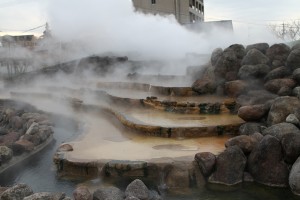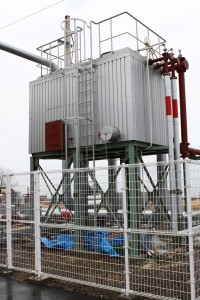 OTEC technology is has a great potential as a base load energy supplier, but its also important to keep up with advances in other renewable technologies that can work with OTEC to supply the full spectrum of future energy demand.
OTEC technology is has a great potential as a base load energy supplier, but its also important to keep up with advances in other renewable technologies that can work with OTEC to supply the full spectrum of future energy demand.
To this end the operating partners in OTEC Okinawa visited Kyushu recently to learn more about the Binary Power plant in Obama Town in Nagasaki Prefecture, visit Xenesys Inc.’s heat exchanger production and research facility, and view Saga University’s Institute of Ocean Energy.
2月5~7日、研修で長崎県雲仙市小浜町と佐賀県伊万里市を訪れました。
小浜町にある温泉の熱を利用したバイナリー発電所と、伊万里市にあるOTECの研究拠点である佐賀大学海洋エネルギー研究センター(IOES)と、熱交換器の研究開発及び製造を行っている㈱ゼネシス伊万里工場を視察するためです。
今回、海洋温度差発電と共通点の多い小浜の発電、そして海洋温度差発電の研究開発に長年取り組んできたIOESとゼネシスの視察を通して、たくさんのことを感じ、学ぶことができました。
Obama Onsen
 The Unzen area of Nagasaki Prefecture has long been known for its many natural hot springs. In Obama there are many natural springs but most of the heat energy is lost. Currently, there is a Binary Power project underway to study the feasibility of using the naturally hot water to create power.
The Unzen area of Nagasaki Prefecture has long been known for its many natural hot springs. In Obama there are many natural springs but most of the heat energy is lost. Currently, there is a Binary Power project underway to study the feasibility of using the naturally hot water to create power.
Binary Power technology is in many ways similar to the systems used for OTEC. Both rely on heat exchangers and a closed system of working fluid to drive a turbine. The project uses water not used by the spring owners to conduct its research which limits the amount of power it can produce, yet the facility is an important first step in proving the technology and learning about the difficulties and benefits of the technology.
At OTEC Okinawa, we too utilize the deep sea water not used by the other Deep Sea Water industries and research center already in place. Over the past year we’ve gained experience in operating OTEC facilities, obtained critical data for future designs, and helped the local economy by boosting tourism and interest in Kume Island‘s green initiatives.
It was great to see other areas of Japan researching and implementing the clean power production facilities of the future.
小浜温泉エネルギー
小浜温泉は約30もの源泉から、100℃程度の高温な温泉が1日に約15,000tも湧き出す、日本でも有数の地域で、「源泉温度×湧出量」で求められる熱量が日本一といわれています。実際、小浜のまちのいたるところで湯煙が立ち上っていました。しかし、昔から活用が検討されてきたにも関わらず、その豊富な温泉水の約70%が使われずに捨てられてきており、今回視察した小浜地熱バイナリー発電は、これまで無駄となっていた熱エネルギーの有効利用という観点からスタートしています。
発電所の中に入るととても暖かく、とても広々としていていました。これまで2,000人以上の見学者を受け入れてきたそうです。(OTEC実証設備は1,500人です!)中には発電機やポンプがあり、またパイプが張り巡らされていて、発電のしくみを詳しく説明していただきました。
発電のしくみは、OTECと同様のバイナリー発電(加熱源系統と媒体系統の2つ(binary)の熱サイクルを利用して発電する方法)で、作動流体も代替フロンを使用、発電の規模も1日あたり50~100kWの発電量(120世帯分)、24時間連続発電が可能なシステムなどなど、OTECとの共通点がたくさんあり、とても親近感がわきました。
また、今後発電後の二次温泉水を、温室栽培や養殖、大人数の露天風呂(ブルーラグーン)など多段階利用することで、地域を活性化させたいという展望も持っていました。久米島でも発電で使い終わった海水はまだ十分使えるので、水産養殖や成分利用、淡水化など、様々な産業に複合利用することで、島の雇用を増やしたいと考えています。
共通点の多い小浜の地熱バイナリー発電と久米島の海洋温度差発電-今後、地域の再生可能エネルギー・産業振興の取組として共に頑張っていきたいと思います。

